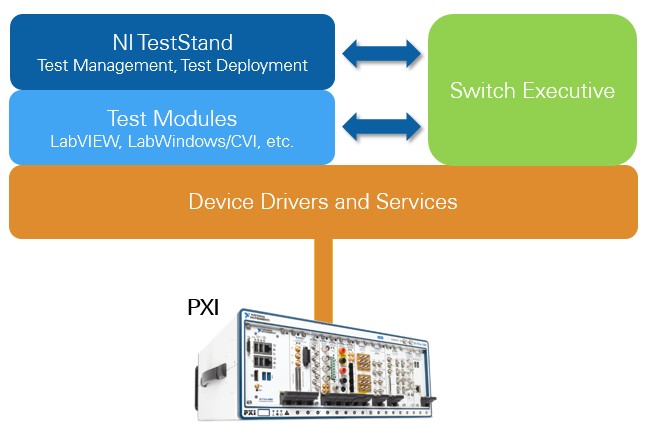Lowering the Cost of Test with Integrated Switch Management
Overview
With NI Switch Executive, developers achieve increased system throughput because the system is aware of which switches are already in the correct position for the next test iteration and does not disconnect switches common to both test iterations. Reducing the total number of switching operations decreases system settling time – ultimately improving the test time of the system.
NI Switch Executive reduces system maintenance with easy-to-use, high-level configuration tools that remove the switch configuration from the test code. In addition, maintaining the position of switches between test iterations can greatly extend the life span of switch hardware, and Interchangeable Virtual Instrument (IVI) compliance adds support for any IVI compliant switches, reducing the risk of downtime from switch hardware obsolescence.
NI Switch Executive seamlessly integrates into the modern software architecture for test. Built on the IVI standard, it works with powerful software such as TestStand™, LabVIEW™, LabWindows™/CVI™, and Measurement Studio™ to offer a uniquely powerful platform for test.
Contents
- Introduction
- Open Software for Switch Management
- Software that Powers Automated Test
- Architectures for Automated Test
- Integrating Switch Executive into TestStand
- Integrating Switch Executive into LabVIEW
- Hardware Integration
- Conclusion
- Related Links
Introduction
Switching is a key component of most automated test systems. With it, developers can reduce the number of instruments required and the size of test systems by sharing instruments for a variety of measurements. However, switching represents a high percentage of the effort and capital equipment costs of building a complete solution. In fact, the cost of the switching subsystems can easily exceed 40 percent of the total automated test equipment (ATE) rack in modern test systems.
At a simple level, switching is as straightforward as using a relay to connect input A to output B. In an application where there are only a few of these routes, developers can easily implement solutions. But modern test systems often require hundreds or thousands of individual routes to connect each of the instruments to every test point of the unit under test (UUT). At the hardware level, this challenge is met by using flexible matrix switches that developers can configure to connect any input to any output; but at the software level, there lacked an intelligent switch management software to manage this problem – until now.
The number of routes possible is only one of the complexities of switching. Switching systems also carry many types of signals. A switching system may, for example, carry a mixture of RF, high and low-bandwidth signals, alongside power supplies, and even optical signals. Additionally, as the switching topologies grow, it may become necessary to add matrix switches together to form larger switching arrays. These conjoined modules require hardwired connections. In hardwired connections, a physical wire is connected to a switch row or column on the first module and then to the respective row or column on the second module. Again, at the software level, developers traditionally have had difficulty remembering each of the possible physical paths and efficiently using them in their test system. Often times, these systems require detailed and cumbersome documents linking switch connections between switch modules, instrument channels, and UUT test points.
Developers encounter another issue when trying to repair or debug the completed switching system. Because in most test systems the switching-control software is embedded deep inside the measurement test code, it can become practically impossible to remember every call to implement a certain route, or recall every test that uses a certain relay. This dilemma means that, in many cases, if even a single relay out of hundreds on a switch module fails, it is less expensive to replace the module than to reprogram the system to route signals around the damaged component.
The solution to this extremely time-consuming, expensive problem is to extract the switching control from the test code. In the past, the only tools that could provide this functionality were based on very high-end test systems that cost $100,000 or more. As an alternative, test developers have had to develop in-house solutions that are expensive to build, support, and maintain. To solve this problem, NI has introduced Switch Executive, a low-cost, powerful tool with which developers can easily create and maintain switching routes and effortlessly integrate switching systems into their test architecture.
Open Software for Switch Management
The core benefits of NI Switch Executive are that it speeds up development, improves throughput, and reduces maintenance of test systems – significantly lowering the cost of building and owning the test system. NI Switch Executive is an easy-to-use development tool that delivers all the flexibility and control that switching applications require. In addition, NI designed Switch Executive to work with any NI or IVI-compliant switching device. By building on the IVI standard, NI Switch Executive can work with any type of switching modules – general-purpose, multiplexer, or matrix modules – and many different configurations such as PXI, VXI, GPIB, or SCXI.
NI Measurement & Automation Explorer (NI MAX) hosts Switch Executive and simplifies the configuration of the NI or IVI-compliant hardware components in a test system. First, developers configure their switching hardware in Measurement & Automation Explorer, and then the configuration information is seamlessly provided to the configuration utilities inside NI Switch Executive.
Once a developer chooses the switch devices in Switch Executive, it becomes easy to name channels and routes with descriptive aliases. This structure removes one of the greatest causes of confusion immediately by providing a simple naming structure independent of the switch vendor's architecture. After a simplified structure has been applied, the user can quickly build routes and groups of routes using interactive tools that provide information on the attributes of the switches. These tools give guidance on which switch modules can handle the signal requirements – from switch bandwidth to impedance and power-carrying capabilities.
The simplicity of Switch Executive dramatically reduces the configuration time of even the most complex systems, accelerating system set-up and making the system easier to debug.
However, configuring the system routes is only half the task, because the user now needs to associate the routes with the actual test or measurement code. To make this aspect of the system development easier, NI has integrated a Switch Executive interface into many of the company’s test development tools, such as TestStand and LabVIEW.
Software that Powers Automated Test
NI built a tightly integrated set of software tools to provide users with rapid application development and shorter time to test. These tools work together to provide a unique platform that encompasses device drivers, application development environments (ADEs), and test management software.
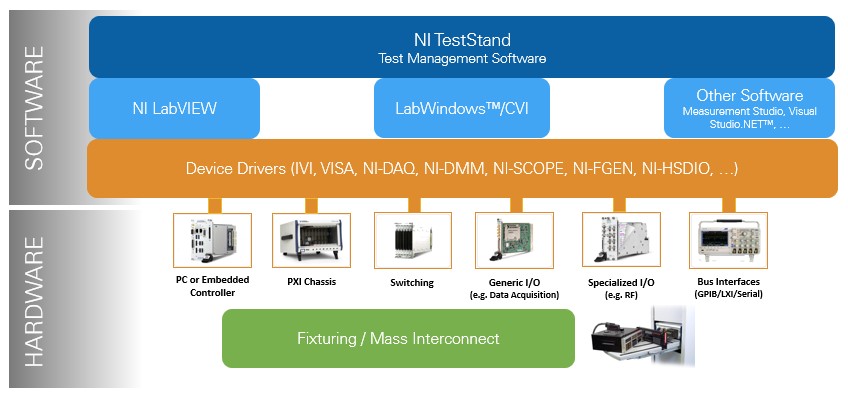
The application development environments (ADEs) include software packages such as LabVIEW, LabWindows/CVI, and Measurement Studio. NI Switch Executive integrates flawlessly into these tools to provide uncomplicated low-level software control.
Test management software is a collection of tools for managing, organizing, and executing tests and large data sets. NI TestStand is a crucial component of the NI framework, which is a ready-to-run test management environment that organizes and executes automated prototype, design validation, and production test systems. TestStand is highly flexible, so developers can modify and enhance their TestStand applications to meet the organization's changing test needs. TestStand provides effortless integration with NI Switch Executive by exposing all of its configured components as test step properties, making it easy to associate existing Switch Executive switch routes with individual steps within a TestStand sequence.
Architectures for Automated Test
Modern architectures for automated tests are largely based around software modularity, which encourages large-scale code reuse. Developers can focus on the actual tests that their products require, without having to develop common features such as reporting, database integration, and user management. This architecture is normally expressed, as shown in Figure 2, with the test management software containing and controlling the tests that are written as test code modules. These modules call to the hardware level, through device drivers, to make a functional measurement, perform a switching operation, or update a control signal. Traditionally, switching has been bound inside the test code module, which has made it difficult to develop and maintain as the system evolves over time. However, as Figure 2 shows, Switch Executive makes it possible to extract the switching requirements and implement the requirements across the whole of the architecture, so developers can apply switching at the required level.
Figure 2: Switch Executive interfaces directly with TestStand, as well as individual test modules.
Integrating Switch Executive into TestStand
TestStand is test executive software with which developers can encapsulate all of the configuration and measurement required for a test into a single TestStand step. This step could be as simple as setting a value or it can be as complex as a complete system test. However, a TestStand step generally contains all of the configuration and measurements required to test a single aspect of the UUT. By enforcing this rule, it is possible to generate truly modular and reusable code, thus reducing future development overhead. A collection of steps is termed a sequence and a developer can create numerous sequences to produce the full test system architecture.
Switch Executive integrates into TestStand and exposes its configurations as TestStand step properties. By doing this, Switch Executive makes it extremely easy for a switching route, or a switching group, to be associated with a TestStand step without integrating the switching operations into the step code. Thus it simplifies the generation and maintenance of a complete system. The TestStand step switching properties are shown in Figure 3.
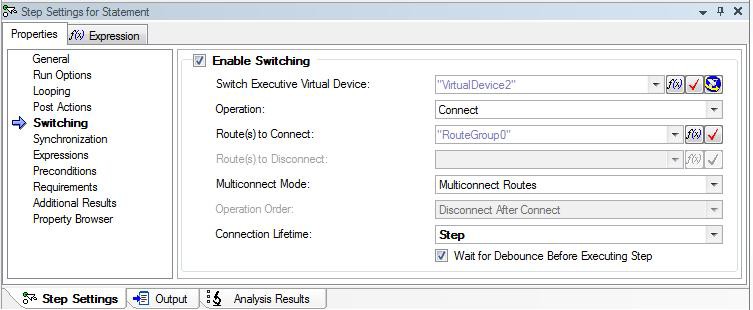
The TestStand step properties contain ring controls that Switch Executive automatically populates. The Switch Executive Virtual Device control defines which switching configurations are required while the Operation control asks whether the step is to connect or disconnect a switch route. The Routes-to-Connect control defines which route, or group of routes, will change and the Connection Lifetime control defines the length of time that this switch route, or group, will be applied – whether that is for the step execution time, for the sequence execution time, or until it is manually disconnected in another step.
Integrating Switch Executive into LabVIEW
The alternative to incorporating the switching into the test management system is to maintain it in the test code module. This approach is a viable option for developers of low-channel-count switching systems. For such users, NI Switch Executive still offers a tremendous advantage in simplifying the code and removing the intricacies of the actual switch route. Figure 4 shows a simple LabVIEW diagram of how developers can implement simple switching routes.
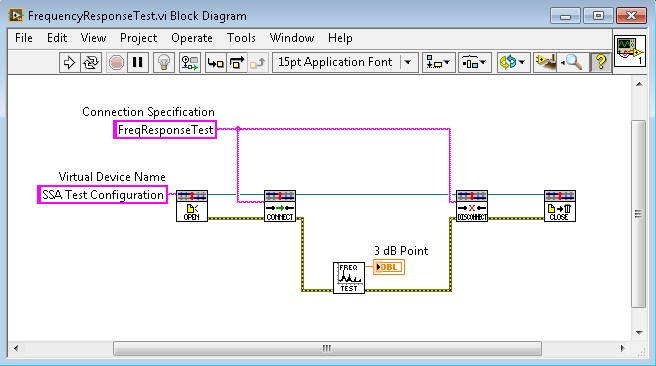
Figure 4: LabVIEW Example of Switch Executive
By implementing switching in LabVIEW through NI Switch Executive, the developer can change the physical route of the signal through the switch matrix because the LabVIEW code calls the route by name. As such, it is easy to update the switch path through the NI Switch Executive configuration environment while the low-level LabVIEW calls remain unaffected.
For many users, the ability to decouple the test code from the physical implementation offers huge saving in long-term maintenance and support. These costs are typically the cost of the entire development. By implementing this dual interface approach, it is possible to save hundreds of hours of debugging if just one relay or switch module fails.
Hardware Integration
Because Switch Executive is based on IVI, the developer can combine many different switch modules in the test system, making the development of the system easier and faster, while offering full interchangeability should the module a developer is using become obsolete. IVI is a key technology in the modern test architecture and it is important to confirm with a switch vendor that his/her product is shipped with an IVI-compliant driver prior to purchase. Most manufacturers, such as NI, Pickering, Ascor, Racal, and Agilent, include IVI drivers with their switch modules.
Figure 5 below illustrates how IVI provides the IVI Class Driver layer so the development environment can call a common interface that in turn calls the correct instrument driver for the specific hardware.

Figure 5: Implementing IVI Delivers Interchangeability of Switches
There are many platforms available for switch hardware, the most common today being PXI, GPIB, SCXI, and VXI. With Switch Executive, all of these types of switch modules can operate together, provided they have either IVI or NI-SWITCH drivers.
VXI and GPIB devices often provide the largest packaging for switching and may offer larger switching arrays, although the comparative cost per relay is normally substantially higher. The alternative to these bulky, slow solutions is to implement a number of PXI or SCXI units together to form a single “virtual” switch. Switch Executive makes the task of developing larger switch configurations substantially easier with the implementation of hard wires into the system description. Previously, if a developer tried to extend the rows or columns from one module to another, he or she had to program it into the code, making it very difficult to understand and debug. With Switch Executive, the hard wires are defined separately and the automatic routing simply integrates the hard wires into the path at design time, saving time and money from development through to deployment.
An advantage of the PXI and SCXI platform is that it has been designed specifically to carry modular switching systems that developers can easily expand. For example, with the NI PXI-2532B matrix switch module and TB-2643B terminal block, users can connect multiple modules together with ribbon cables. This simple accessory accomplishes in seconds what would otherwise take hours to create by hand using individual wires, while eliminating any possibility of error in the wiring. Figure 6 depicts three NI PXI-2532B switch modules connected using this method.
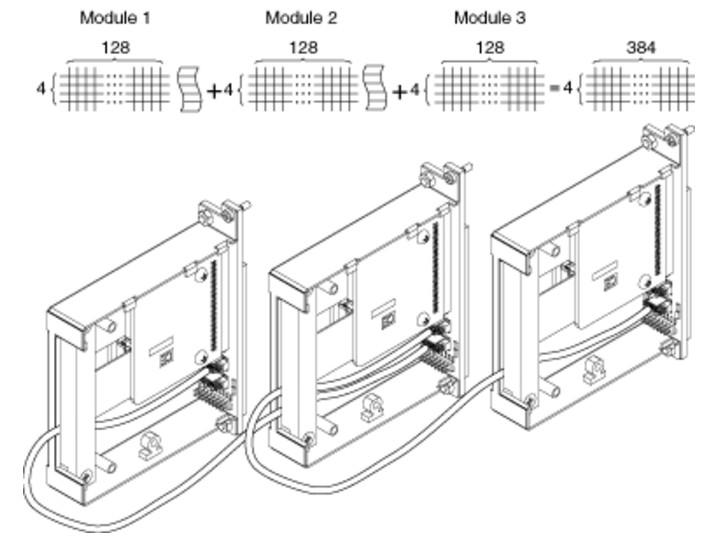
Conclusion
Integrating Switch Executive into modern test architectures substantially decreases the time it takes to deliver the test system to the production floor, while increasing throughput and minimizing maintenance over the lifetime of the system.
The modern test architectures – based on Switch Executive, TestStand, and advanced development environments – deliver low-cost technologies that were once only available in vendor-defined, high-end systems costing more than $100,000. NI has made technologies such as switch and test management available to a broader audience by making it affordable, easy to use, and easy to maintain, giving companies a competitive edge with a lower cost of test and far shorter time to market.
